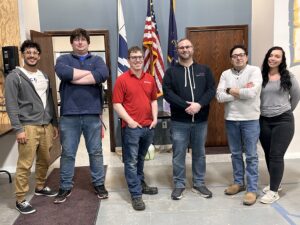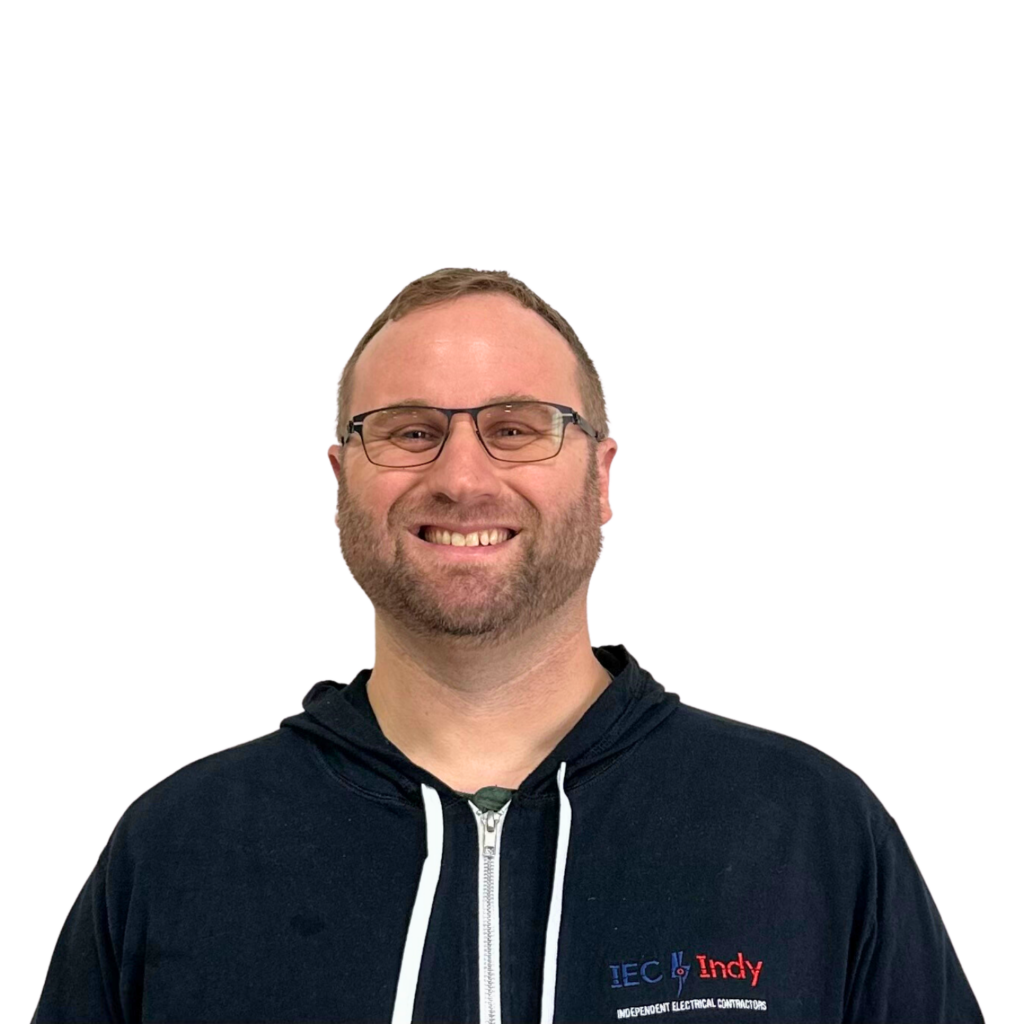IEC lists the following essential skills, education, and experience for becoming an IEC instructor:
- Five years of experience actively performing work on electrical systems in the construction, repair, or design as they pertain to the residential, commercial, or industrial industry.
- Knowledge and understanding of the National Electrical Code®.
- Teaching experience preferred, but not required upon demonstrating adequate teaching skills.
After speaking with Ed Brown, IEC instructor and director of education and operations at IEC Indy, we might want to add one more — heart.
“As an apprentice, IEC gave me training and knowledge to do my job with confidence,” says Ed. “I want to give that back. I want to see others around me make a living for themselves, be able to support their families like I was able to support mine. My passion is seeing people better themselves.”

Ed’s Path
Ed originally moved to the Indianapolis area after high school to attend Bible college and pursue a career in the ministry. As he started to raise and support a family, he began working for an air quality contractor changing out filters for smoking sections in bars and restaurants. He became more and more interested in electrical as he became part of the team installing new fans and new filter systems. Looking to find a career to better help support a family, Ed followed that interest in the electrical trade in 2007 taking a job with a local electrical contractor and enrolling in the IEC Indy Apprenticeship Program. He graduated top of his class in 2011, feeling certain he had chosen the correct career path for himself and his family.
He worked for a couple different contractors as a foreman and as a field supervisor, operations in service work, and facilities management. He weathered some tough times during the recession but stuck with it.
Initially, Ed had passed on the opportunity to become an IEC instructor just after graduation when one of his well-respected instructors said he would be great at it since he had a good understanding of the material and was able to explain it to his colleagues throughout his apprenticeship.
“Although I was flattered, at the time I didn’t feel it was for me,” Ed says. “In 2015, a friend and past coworker of mine, Blake Behr, who had become very involved at IEC Indy, encouraged me to reconsider becoming an instructor. With a few more years of experience behind me I felt like it was time to give it a shot. After all, for me the IEC has given me the training and the knowledge to not just do my job, but to do it well, and I wanted to give back since they had given me so much. I began as Blake’s assistant instructor that year and as a lead instructor the year after that.”
He joined IEC Indy as a full-time instructor in July of 2020.
IEC Indy offers three types of electrical apprenticeship programs — the traditional IEC program where a student works full-time with a local contractor and attends class one night a week for four years. The second option they offer is the accelerated apprenticeship with two classes per week for two years while working days with a contractor. The third option is the full-time electrical training program with three, daytime, eight-hour classes per week, including hands-on experience to prepare students to enter the electrical industry with understanding and training prior to working with a contractor.
Throughout his IEC Indy career, Ed has taught in all three programs, at all levels. IEC Indy has 11 instructors, including Ed, and is running eight apprenticeship classes this session. The chapter is looking to add an onboarding “Bootcamp” program for new apprentices. In this program, IEC Indy would take students with little to no experience and run them through two weeks of training — how to use tools, how to wire an office building, how to read drawings. The concept behind the program is to train students to perform the 20 percent of tasks that an electrician does 80 percent of the time in the field.
“This allows the students to see if this is a type of work they will connect with, and also it allows our contractors to see if the worker is a ‘fit’ before they spend time and money on them in an apprentice program,” Ed says.
“I’ve been in my new role as director of education and operations, overseeing all of our education, for about a year now,” says Ed. “I also continue to teach two nights each week. IEC Indy has seen about 290 apprentices in classes this year. That’s a big number for us, as Indiana is a state where apprenticeship training is not required to take the masters exam through the state electrical board.”
Working the Classroom
Ed has learned much in his nearly 10-year teaching career. A few lessons stand out for him — everyone learns differently, one needs to find new ways to teach the same thing over and over again, and you need to figure out where your students are at and then teach there. 
That last one is the toughest for Ed, but he feels it is the most important.
“Some concepts are more difficult to teach than others, but often it is different for every student,” Ed says. “I have seen over the years that everyone learns differently. Some may pick up well on written text and lecture over concepts such as electrical theory, transformers, and current flow. And the next year the same students struggle to learn controls and ladder logic. I have found it beneficial as an instructor to be aware of the individual students and their learning styles. Now it is impossible to always be everything to everyone, but taking the time to find new ways to teach the same things is important. I have seen a huge difference in retaining knowledge by taking the time to learn my students and figure out where they are at and help get them to where they need to be.”
He shares a recent success story, where one of his students was having a difficult time getting his mind wrapped around relays and controls. Ed says he was the type of student who would always do phenomenal at theory and code as well as standard wiring and switching. But controls, ladder logic, and relays seemed to just escape him.
“We had a small discussion during one of our labs where I took two three-way switches, something that he was familiar with, and demonstrated with those switches just how controls and relays are just like switching with one switch controlling another,” Ed explains. “With a little bit of understanding now in his ‘toolbox’ he took that concept back to the classroom and mulled over the concepts I had just brought to light. He then promptly came back out into the lab area and completed the lab with time to spare, and even began to aid the other students in learning the concepts. He ended up being one of the top apprentices in controls work that year and went on to compete in the IEC National Apprentice of the Year competition and took first place in the controls portion of the competition.”
Ed tells of another student who was struggling with the same concepts, so he asked him to start assisting one of the night class instructors in a class that he was not part of. Ed says that by assisting the controls instructor, he started to understand the concepts and brought his grade to not just passing, but passing well.
Serving National Too
Ed doesn’t keep all he’s learned just for the benefit of IEC Indy. He serves IEC National as a member of the A&T Committee, Curriculum Development Group, and Hands-On Activities Subcommittee. He recently threw his hat into the ring to become involved on a National Electrical Code® panel.
Serving these groups means he’s able to ‘give back’ even more in gratefulness for what he has been able to achieve through IEC and, of course, he learns even more by working with some of the best instructors and leaders nationwide. These groups spent the last year doing code updates and a curriculum update for apprentice year three and he learned much from his fellow volunteers.
A People Person
Ed thrives on working together to bring out the best in himself and in others.
“I’d say my biggest inspiration is my wife, Lindsey,” Ed says. “She is always supporting me no matter what; she is my rock.”
Ed also credits Blake Behr with always encouraging him to be and to do better. He met Blake during his time in Bible college when he was involved in church youth ministry. Blake was a teenager in the program, and Ed a college student and youth leader. Today, Ed continues to be active in his church as worship leader and overseeing the entire music ministry.
Finally, he credits the IEC Indy team of seven for hard work and dedication and Executive Director Raul Vasquez for encouraging him to become involved on the National level.
“Our Indy team works together well to best teach our IEC Indy apprentices,” Ed says.


